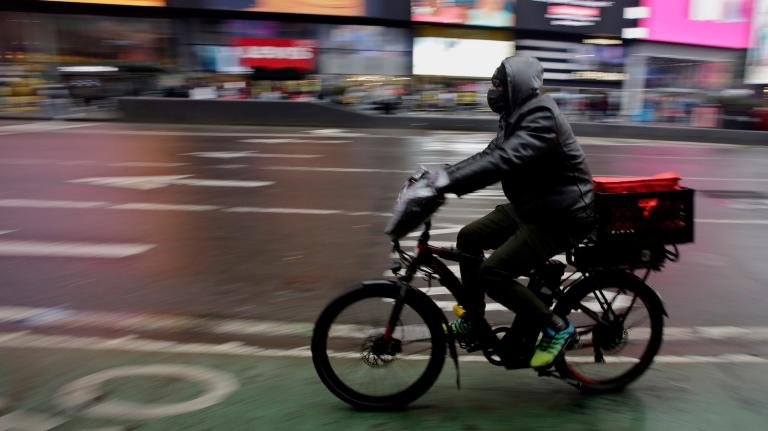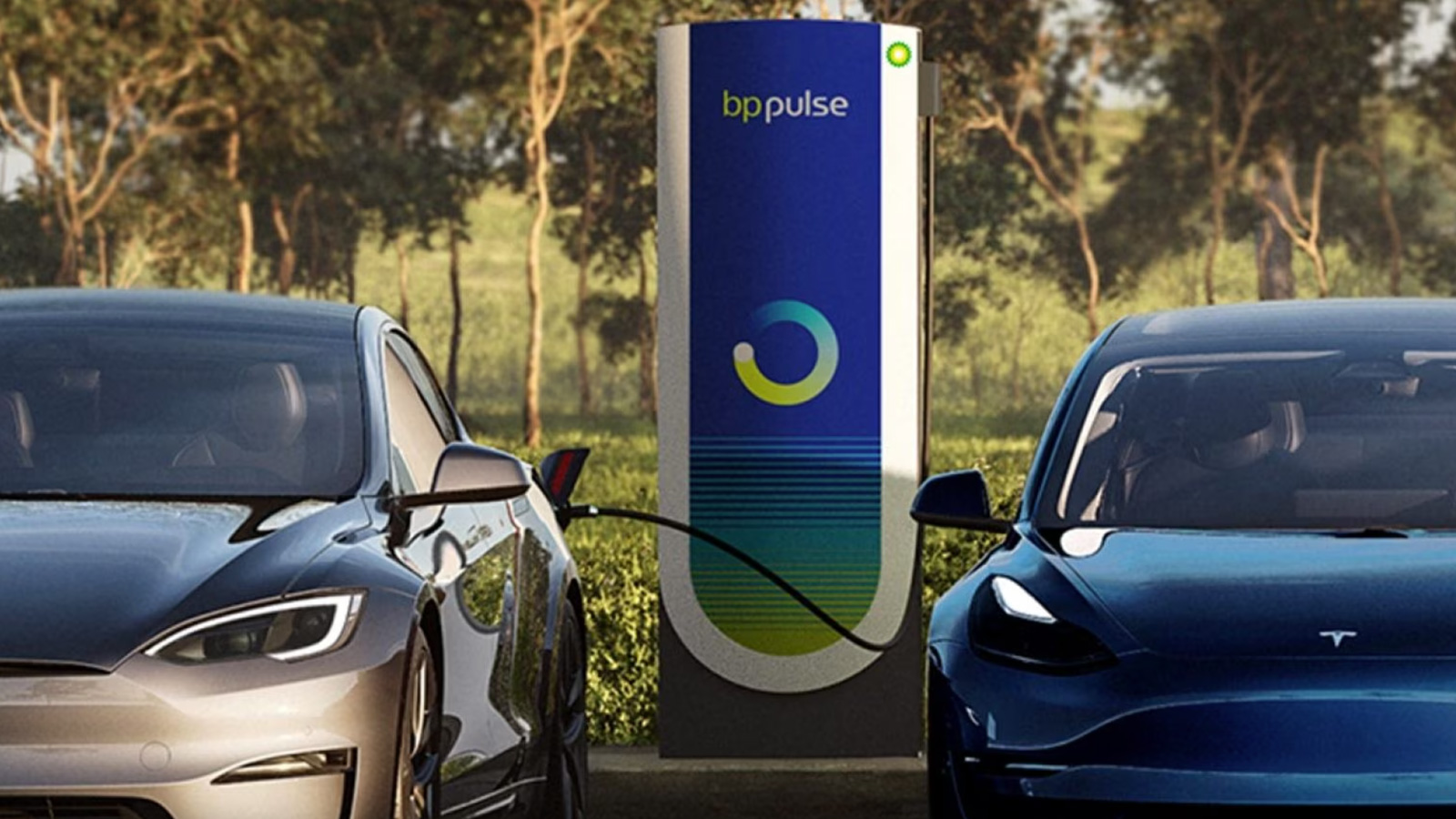For car buyers considering whether to go electric, one tradeoff they must weigh is whether to give up the convenience of finding a gas station almost anywhere and being able to refuel in minutes. Fast-charging an EV can take 20 to 30 minutes, and charging stations, for now, are not ubiquitous.
The gap between the two experiences is narrowing, however, as charge times speed up and stations become more common. An unprecedented agreement between the nation’s leading EV company and one of the world’s oil giants may bring them even closer.
British energy company BP announced Thursday that it will spend $100 million buying Tesla ultrafast chargers to build out its “BP pulse” network in the United States. It will begin installing the self-branded chargers next year at its BP and Amoco gas stations, AMPM and Thorntons convenience stores, and TravelCenters of America truck stops, as well as at large “Gigahub” charging sites in major cities.
“Combined with our vast network of convenience and mobility sites on and off the highway, this collaboration with Tesla will bring fast and reliable charging to EV drivers when and where they need it,” Richard Bartlett, global CEO of BP pulse, said in a statement.
The deal marks the first time Tesla will sell its chargers — further cementing its dominance of the EV charging space — and is one of the largest investments by an oil and gas company into the technology in the U.S. Coupled with a federal initiative to build charging infrastructure along highway corridors, BP’s move could help reshape where drivers access public charging.
But it also raises questions about how much EV charging should mimic the experience of refueling a combustion car, and whether drivers will want to plug in at convenience stores and gas stations.
BP may seem an unlikely candidate for such a big bet on EVs. It produces about 2.3 million barrels of oil daily, and its fossil fuel dealings earned it a record $28 billion in profits last year. The company is perhaps best known for the 2010 Deepwater Horizon disaster, in which a drilling rig in the Gulf of Mexico exploded, killing 11 people and releasing 200 million gallons of oil into the ocean over 87 days.
In 2020, BP declared a change in direction. It committed to becoming net-zero by 2050, and said it would cut oil and gas production by 40 percent in 10 years. (It recently adjusted that goal to 25 percent.)
This new strategy included expanding its convenience-store business and building EV charging networks. BP announced plans this year to invest $1 billion in U.S. charging infrastructure by 2030 and to install 100,000 charge points globally by then. It also acquired the TravelCenters of America chain of truck stops, adding another 280 potential installation sites.
Now BP will gain access to one of the most recognizable chargers in the U.S. Tesla has more than 12,000 Supercharger stations across North America, owns more than 60 percent of the fast-charge hardware in the U.S., and is known for having the best reliability, locations, and user experience.
The 250kW BP chargers will use Tesla’s “Magic Dock” connector, which is compatible with both Tesla’s charging standard and the CCS standard currently used by most other automakers.
While BP is the first petroleum company to buy chargers from Tesla, it’s not the only one trying to find its way in the EV transition.
Shell has said it wants to become “a national EV charging network provider,” and own more than 200,000 EV charge points globally by 2030. In April, it bought the EV charging network Volta for $169 million. Chevron announced a partnership with Freewire Technologies last year to install charging stations at its gas stations. It also has invested in the charging startup Electric Era.
The oil majors are likely preparing for a fast approaching transformation of American roads: The analytics firm S&P Global Mobility estimates that there will be nearly 41 million EVs in the U.S. by 2030.
“If battery electric vehicles do prove to be the major means of light passenger vehicle transportation moving forward, the core business model for the oil majors of providing gasoline to these vehicles is going to struggle,” Graham Evans, director of auto supply chain and technology at S&P Global Mobility, told Grist. “And therefore how do they replace that? By providing EV charging.”
Fossil fuel companies may also be feeling pressure to change how they’re publicly perceived, said Evans. “It’s not necessarily just hedging their bets, but perhaps starting to add some meat on the bone of the narrative around decarbonizing what they do, and meeting some kind of net-zero target for the future, as difficult as that will be to achieve.”
Gas companies looking to add EV charging are also getting a generous boost from the $5 billion National Electric Vehicle Infrastructure, or NEVI, grant program, which funds the installation of charging stations along “alternative-fuel corridors,” mainly interstate highways.

Part of the administration’s effort to install 500,000 EV chargers by 2030, the program requires that chargers be installed every 50 miles along the corridors, and within one mile of exits. Some states go even further, mandating amenities like WiFi, 24-hour access to bathrooms, and food for purchase.
Those rules are giving gas stations, convenience stores, and travel centers a competitive advantage. Of the $90 million dispersed so far, they’ve received more than 60 percent of the funding, according to Loren McDonald, founder of the analytics firm EVAdoption.
“They tend to be the ones that best fit all the different requirements,” McDonald told Grist. “We’ve seen all of the majors step up, because they have the resources, they have the real estate, they have everything.”
But some transportation advocates say that strategy doesn’t reflect where drivers want to plug in, or how those dollars can best benefit communities.
“Gas stations are not the place to charge,” Corrigan Salerno, a policy associate at the transportation advocacy organization Transportation for America, told Grist. “We can’t just do everything we used to with [combustion] vehicles but with EVs.”
That’s because refueling an electric car is a fundamentally different process. Charging an EV to 80 percent (the optimal level to preserve battery life) with a fast charger takes 20 to 40 minutes, depending on the car and charger speed. That’s not an amount of time that drivers want to spend at a gas station or convenience store, said Salerno, who added that Tesla chargers get favorable ratings from customers not just because of reliability, but because they are often located within walking distance of amenities.
“People are really affected by the environment that they charge at,” he said. “The quality of the site needs to be considered more than proximity to the highway, otherwise people might end up regretting buying their EVs because of the misery of charging at bad sites.”
Offering a few chargers may not be that advantageous for gas-station operators either. Most of their profits depend on a high volume of convenience-store purchases, which requires a lot of customers spending a little bit of time on site, not the reverse.
“It probably won’t drive the transition between the initial phase of showing you’re in the game,” Ryan Fisher, BloombergNEF’s head of charging infrastructure, told Grist.
Fisher predicts that in the long term, more public charging will take place at bigger sites. BP is planning so-called Gigahubs, which could charge more than 100 cars at a time, in city metros and near airports. The company has already installed one in Birmingham, England, with 16 ultra-fast chargers and 150 Level 2 chargers, similar to the ones drivers use at home.
For now, much of this large-site installation is occurring at retailers like Walmart, which has more than 1,300 chargers through a partnership with Electrify America and plans to build its own network. “The supermarkets subsidize the energy, they get you in the store, you buy more stuff,” said Fisher. “It’s a reasonably simplistic model to think about.”
And it’s one that creates real competition for oil and gas majors, something they’re less accustomed to in the fuel market for combustion cars.
There’s also the question of whether EV drivers will want to give their money to the fossil fuel companies that willfully ignored climate change for decades and deceived the public about its impact. Evans of S&P Global said that he hasn’t seen data on EV drivers’ feelings about the oil majors, but that when choosing where to charge, necessity may trump distaste.
“At the moment there is such a lack of prevalent, reliable charging infrastructure,” he said, “that if you have charging stations and they work reliably, consumers will use them.”




